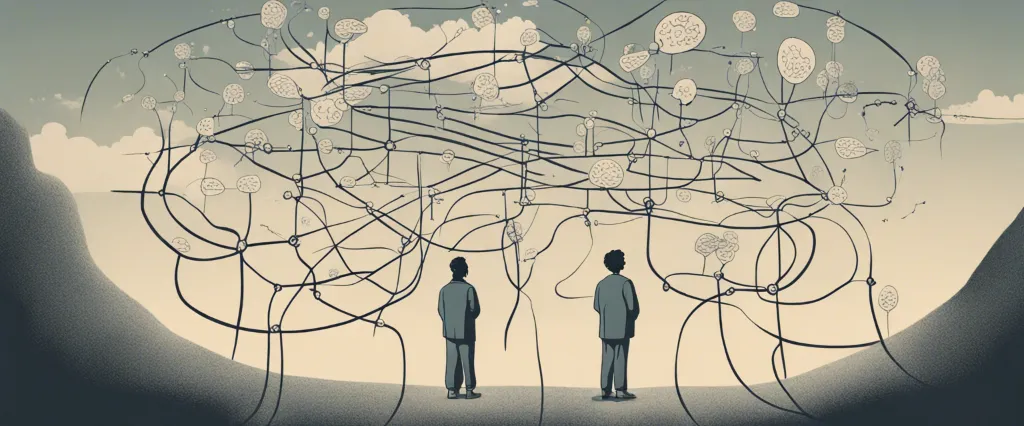
As the world of social networks and data analysis continues to reshape our understanding of human behavior, few individuals have made a more profound impact than Duncan J. Watts. With his extensive research and groundbreaking contributions to the field of network science, Watts has emerged as a leading thinker in unraveling the complexities of social networks, decision-making, and collective behavior. Join us today as we delve into the mind of this influential researcher, exploring his unique perspectives, experiences, and profound insights into the fascinating world of networks and social dynamics. Welcome to an enlightening conversation with the brilliant mind of Duncan J. Watts.
Duncan J. Watts is a renowned sociologist, scientist, and author who has made significant contributions to the fields of network science and computational social science. With a diverse background in physics, his work focuses on understanding and analyzing complex systems, particularly social and biological networks.
Born on April 1, 1971, in Toronto, Canada, Watts obtained his Bachelor’s degree in Physics from the University of New South Wales in Australia. He then went on to pursue his Ph.D. in Theoretical and Applied Mechanics at Cornell University, where he developed a keen interest in the dynamics of complex systems.
Watts gained international recognition for his groundbreaking research on network theory, which explores the patterns and structures of interconnected relationships among individuals, organizations, and even online platforms. His notable work on the small-world network, often referred to as the “six degrees of separation,” demonstrated how individuals in social networks could be connected through a surprisingly small number of intermediaries. This theory shattered conventional beliefs about the limitations of human social relations and their potential for influence.
Throughout his career, Duncan J. Watts has held prestigious positions in academia, including serving as a Professor of Sociology at Columbia University and as a Principal Research Scientist at Microsoft Research. His research has made a lasting impact on various disciplines, from sociology and psychology to economics and computer science, advancing our understanding of collective behavior, market dynamics, and the spread of information.
Watts has authored several influential books, including “Six Degrees: The Science of a Connected Age” and “Everything is Obvious: Once You Know the Answer.” In his writings, he challenges prevailing assumptions and offers fresh perspectives on human behavior, encouraging readers to examine phenomena through the lens of complexity.
Recognized for his exceptional contributions, Duncan J. Watts has received numerous accolades, including being named a Fellow of the American Physical Society and awarded the Guggenheim Fellowship for his exceptional research endeavors. His thought-provoking work continues to shape the future of social science, as he uncovers hidden patterns and uncovers insights into how individuals and societies operate within interconnected systems.
10 Thought-Provoking Questions with Duncan J. Watts
1. Can you provide ten Everything is Obvious by Duncan J. Watts quotes to our readers?
Everything is Obvious quotes as follows:
a) “We can only make sense of the world by simplifying it.”
b) “Debunking conventional wisdom is hard because it requires us to question ourselves.”
c) “Being right is not necessarily the same as being persuasive.”
d) “The more information we have, the more we seek out confirming evidence.”
e) “We often judge the quality of a decision by its outcome, rather than the quality of the decision-making process.”
f) “Common sense is the enemy of scientific inquiry.”
g) “Success is not just about talent and hard work; it also depends on many factors beyond our control.”
h) “What seems obvious to us may not be apparent to others.”
i) “Social influence and network effects shape our behaviors more than we realize.”
j) “There are no foolproof solutions or one-size-fits-all answers in complex systems.”
2.What inspired you to write “Everything is Obvious”? Can you share the inspiration behind the book and explain why you believed it was important to challenge common assumptions about the predictability of human behavior and the limitations of common sense?
The inspiration behind writing “Everything is Obvious” stems from my fascination with the disconnect between how we believe the world works and how it actually does. Throughout my career as a sociologist and network scientist, I observed a recurring pattern – our instinctive reliance on common sense often led us astray when trying to understand and predict complex human behavior.
I believed it was crucial to challenge these common assumptions because they impose limitations on our ability to comprehend and navigate the modern world. Our implicit trust in common sense can blind us to alternative explanations or approaches, hindering progress in various domains such as business, politics, and personal decision-making.
By investigating and questioning the predictability of human behavior, I aimed to encourage a more nuanced understanding of the social world. I wanted to convey that human behavior is influenced by intricate networks and contexts, making it difficult to rely solely on traditional wisdom or intuition.
Through this book, I sought to provoke readers to reconsider their assumptions and embrace a more humble and open-minded approach to understanding the complexities of human behavior and the limitations of our own common sense.
3.Your book delves into the concept of social networks and their influence on human behavior. Can you highlight some of the key insights and experiments from “Everything is Obvious” that shed light on how social networks shape our choices and actions, as discussed in your book?
In my book “Everything is Obvious“, I explore the intricate relationship between social networks and human behavior. Through various insights and experiments, I shed light on how social networks shape our choices and actions in powerful ways.
One key insight is the idea that our decisions are not solely driven by individual preferences or rational thinking. Rather, our choices and actions are heavily influenced by the social context in which we exist. Social networks play a crucial role in transmitting information, attitudes, and behaviors, creating a ripple effect that can dramatically impact our own decision-making.
One of the experiments discussed in the book, conducted by sociologist Mark Granovetter, demonstrates the power of weak ties in social networks. It shows that when it comes to finding a job, our distant acquaintances (weak ties) are often more valuable than our close friends or family. This insight challenges the conventional wisdom that strong ties are always more influential, suggesting that our networks of weak ties provide access to novel information and opportunities.
Additionally, my book highlights the fascinating experiment conducted by psychologist Stanley Milgram, known as the “small world experiment.” Through this experiment, Milgram discovered that individuals are connected to each other by surprisingly short chains of acquaintances. This finding gave birth to the concept of “six degrees of separation,” illustrating how small the world truly is and how interconnected we are through social networks.
Overall, “Everything is Obvious” emphasizes the fundamental role that social networks play in shaping our choices and actions. By understanding and harnessing the power of these networks, we can better navigate the complexities of our social worlds and make more informed decisions.
4.”Everything is Obvious” emphasizes the complexity of human behavior and the limitations of hindsight bias. How can readers use the knowledge and awareness presented in your book to become more critical thinkers and avoid the trap of oversimplification and hindsight judgment, as discussed in your book?
In “Everything is Obvious,” I emphasize the complexity of human behavior and highlight how hindsight bias leads us to oversimplify and judge events with the benefit of hindsight. By understanding the limitations of our own thinking and recognizing that outcomes are often influenced by a multitude of complex factors, readers can become more critical thinkers.
To avoid oversimplification and hindsight judgment, it is crucial to question our assumptions and consider alternative explanations for events. Recognize that the world is interconnected, and individual actions can have unforeseen consequences. Seek diverse perspectives and gather different sources of information to combat confirmation bias.
In my book, I provide case studies and examples to illustrate how small changes in initial conditions can lead to vastly different outcomes, challenging our tendency to oversimplify. By embracing uncertainty and nuance, readers can cultivate a more thoughtful approach, acknowledging that predicting human behavior and events is challenging.
Ultimately, my book encourages readers to practice humility, actively question their own assumptions, and approach problems with an open mind, avoiding oversimplification and hindsight judgment to become more astute critical thinkers.

5.Your book discusses the concept of counterintuitive findings and the role of randomness in outcomes. Can you provide insights into how readers can apply the lessons of unpredictability and chance to make more informed decisions in their personal and professional lives, as discussed in your book?
In my book, I discuss the concept of counterintuitive findings and the significant role that randomness plays in shaping outcomes. To apply the lessons of unpredictability and chance in personal and professional decision-making, readers can consider the following insights:
1. Embrace uncertainty: Recognize that outcomes are often subject to random influences, and it is impossible to predict every variable. Instead of striving for perfect accuracy, focus on understanding the range of possibilities and potential consequences.
2. Experimentation: Adopt a mindset of experimentation and learning. By trying different approaches and gathering data on outcomes, individuals can uncover unexpected insights and adjust their decisions accordingly.
3. Diversify strategies: Engage in diverse activities and approaches, both personally and professionally. Exploring different paths can enhance the likelihood of encountering favorable chance occurrences and maximizing opportunities.
4. Collaboration and networks: Engage in collaborations and cultivate diverse networks. Interacting with a wide range of individuals can increase the chances of encountering novel ideas and unexpected opportunities.
5. Continuous learning: Stay informed and up-to-date in relevant fields, as this helps in identifying emerging trends and adapting to unpredictable changes effectively.
By integrating these notions into decision-making processes, individuals can navigate the inherent unpredictability of outcomes in a more informed and adaptive manner.
6.Navigating the complexities of human behavior often involves embracing uncertainty and humility. What advice do you offer to readers for approaching problems and decision-making with a more open and adaptable mindset, as discussed in your book?
When it comes to navigating the complexities of human behavior, embracing uncertainty and humility is essential. My advice to readers is to approach problems and decision-making with an open and adaptable mindset. Recognize that the social world is intricate and unpredictable, making it impossible to have all the answers. Embracing uncertainty means acknowledging that there are limits to our knowledge and that multiple explanations can coexist. It is crucial to value diverse perspectives and be willing to revise our assumptions when confronted with new evidence. Additionally, humility is key. Acknowledge that even experts can make mistakes and that there are limitations to our understanding. Embrace a willingness to learn from others and be open to continuous learning and growth. By embracing uncertainty and humility, readers can foster a more open-minded and adaptable mindset when facing the complexities of human behavior, leading to better decision-making and problem-solving.
7.”Everything is Obvious” explores the idea of challenging conventional wisdom and questioning assumptions. How can readers cultivate the habit of questioning prevailing beliefs and seeking evidence-based approaches to understanding and influencing human behavior, as discussed in your book?
In “Everything is Obvious,” I explored the concept of questioning conventional wisdom and assumptions. To cultivate the habit of questioning prevailing beliefs and seeking evidence-based approaches, readers can start by acknowledging the limitations of intuition and common sense. Understanding that these are often subject to biases and errors is crucial. Embracing a scientific mindset is essential, where curiosity and empirical evidence drive the search for understanding.
Additionally, readers can benefit from actively seeking out diverse perspectives and challenging their own preconceived notions. Engaging in critical thinking and encouraging intellectual humility can help unravel deeply-rooted beliefs. This involves being open to new evidence, even when it contradicts conventional ideas.
Moreover, readers can develop the practice of seeking evidence-based approaches by engaging with research and scientific literature. By keeping up with the latest studies and understanding the methodologies behind them, individuals can better evaluate claims and make informed decisions.
Ultimately, cultivating the habit of questioning prevailing beliefs requires a willingness to challenge ourselves and be intellectually flexible. By doing so, we can better understand and influence human behavior in more effective and meaningful ways.
8.Your book addresses the importance of network thinking and the interconnectedness of individuals and ideas. Can you share strategies for readers to develop network thinking skills and leverage the power of networks in various aspects of their lives, as discussed in your book?
In my book, I emphasize the significance of network thinking and the role it plays in our interconnected world. To develop network thinking skills and harness the power of networks, readers can adopt the following strategies:
1. Embrace diversity: Engage with people from different backgrounds, cultures, and disciplines. By broadening your network, you increase the likelihood of encountering diverse perspectives and ideas.
2. Be open and curious: Remain receptive to new ideas and approaches. Actively seek out different opinions and challenge your own assumptions. This mindset fosters creativity and enables novel connections.
3. Foster collaborations: Actively facilitate collaborations and interactions among individuals. Encourage collective problem-solving and information sharing to leverage the wisdom of crowds and tap into the collective intelligence.
4. Emphasize weak ties: Cultivate connections beyond your close circle of friends and colleagues. Weak ties often serve as bridges to new knowledge and opportunities.
5. Leverage technology: Utilize online platforms and social media to connect with like-minded individuals, find new resources, and tap into shared expertise.
By incorporating these strategies and adopting a network-oriented mindset, readers can effectively navigate today’s interconnected world to enhance various aspects of their lives, from personal relationships to professional endeavors.
9.”Everything is Obvious” offers a path to greater awareness of the complexity of human behavior. Could you describe the transformative journey that readers can embark on by applying the principles of humility, critical thinking, and network understanding outlined in your book?
In “Everything is Obvious,” readers can embark on a transformative journey of understanding the complexity of human behavior by embracing principles of humility, critical thinking, and network understanding. The book challenges the common belief that human behavior is predictable and easily explained. By cultivating humility, readers learn to acknowledge their limited knowledge and resist the temptation to view events as obvious after they happen.
Embracing critical thinking, readers start questioning their assumptions and recognize the potential for mistakes in their judgments. They become aware of the biases and cognitive shortcuts that often lead to flawed interpretations of human behavior.
Furthermore, the book emphasizes the significance of network understanding, highlighting that human behavior is influenced by intricate and interconnected social networks. By appreciating the power of social influence, readers gain a fresh perspective on how behavior emerges and spreads throughout these networks.
Ultimately, by applying these principles, readers embark on a path towards greater awareness of the complex mechanisms that give rise to human behavior. They are encouraged to challenge simplistic explanations, approach situations with an open mind, and recognize the multitude of factors at play. This journey allows for a deeper understanding of human behavior and a more nuanced view of the world around us.

10. Can you recommend more books like Everything is Obvious?
A. Blink: The Power of Thinking Without Thinking” by Malcolm Gladwell
In this thought-provoking book, Gladwell explores the power of our subconscious mind and its ability to make split-second decisions. Drawing on various examples and research, he challenges our belief in rational decision-making and highlights the role of intuition and snap judgments in everyday life.
B. Nudge: Improving Decisions About Health, Wealth, and Happiness” by Richard H. Thaler and Cass R. Sunstein
Thaler and Sunstein present an insightful look into the field of behavioral economics and how small nudges can have a significant impact on our decisions. They explain how our choices are influenced and provide practical strategies to make better decisions while maintaining our freedom of choice.
C. Predictably Irrational: The Hidden Forces That Shape Our Decisions” by Dan Ariely
Ariely delves into the irrational behavior exhibited by humans when making choices. Using experiments and anecdotes, he uncovers the biases and cognitive fallacies that affect our decision-making processes and reveals how we can become more aware of and overcome these irrational tendencies.
A. Thinking, Fast and Slow” by Daniel Kahneman
Kahneman, a Nobel laureate, presents a comprehensive exploration of the two systems that drive our thinking: the fast, instinctive, and emotional system, and the slow, deliberate, and logical system. Through fascinating insights, he reveals the flaws in our thinking and offers ways to improve decision-making.
B. The Black Swan: The Impact of the Highly Improbable” by Nassim Nicholas Taleb
Taleb challenges our tendency to rely on predictable patterns and forecasts, arguing that rare and unpredictable events shape our world more than we acknowledge. He discusses the concept of black swans, events with extreme impact and rarity, and explores their implications on decision-making and the nature of uncertainty.
By exploring these books, readers will gain a deeper understanding of the hidden forces that shape our decisions, the flaws in our thinking, and strategies to make better choices. These thought-provoking works will challenge conventional wisdom and provide valuable insights into human behavior, decision-making, and the complexity of our world.